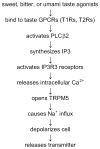TRPs in taste and chemesthesis
- PMID: 24961971
- PMCID: PMC4667542
- DOI: 10.1007/978-3-319-05161-1_5
TRPs in taste and chemesthesis
Abstract
TRP channels are expressed in taste buds, nerve fibers, and keratinocytes in the oronasal cavity. These channels play integral roles in transducing chemical stimuli, giving rise to sensations of taste, irritation, warmth, coolness, and pungency. Specifically, TRPM5 acts downstream of taste receptors in the taste transduction pathway. TRPM5 channels convert taste-evoked intracellular Ca(2+) release into membrane depolarization to trigger taste transmitter secretion. PKD2L1 is expressed in acid-sensitive (sour) taste bud cells but is unlikely to be the transducer for sour taste. TRPV1 is a receptor for pungent chemical stimuli such as capsaicin and for several irritants (chemesthesis). It is controversial whether TRPV1 is present in the taste buds and plays a direct role in taste. Instead, TRPV1 is expressed in non-gustatory sensory afferent fibers and in keratinocytes of the oronasal cavity. In many sensory fibers and epithelial cells lining the oronasal cavity, TRPA1 is also co-expressed with TRPV1. As with TRPV1, TRPA1 transduces a wide variety of irritants and, in combination with TRPV1, assures that there is a broad response to noxious chemical stimuli. Other TRP channels, including TRPM8, TRPV3, and TRPV4, play less prominent roles in chemesthesis and no known role in taste, per se. The pungency of foods and beverages is likely highly influenced by the temperature at which they are consumed, their acidity, and, for beverages, their carbonation. All these factors modulate the activity of TRP channels in taste buds and in the oronasal mucosa.
Figures







References
-
- Abe J, Hosokawa H, Okazawa M, Kandachi M, Sawada Y, Yamanaka K, Matsumura K, Kobayashi S. TRPM8 protein localization in trigeminal ganglion and taste papillae. Brain Res Mol Brain Res. 2005;136:91–98. - PubMed
-
- Adachi R, Sasaki Y, Morita H, Komai M, Shirakawa H, Goto T, Furuyama A, Isono K. Behavioral analysis of Drosophila transformants expressing human taste receptor genes in the gustatory receptor neurons. J Neurogenet. 2012;26:198–205. - PubMed
-
- Adcock JJ. TRPV1 receptors in sensitisation of cough and pain reflexes. Pulm Pharmacol Ther. 2009;22:65–70. - PubMed
-
- Akopian AN. Regulation of nociceptive transmission at the periphery via TRPA1-TRPV1 interactions. Curr Pharm Biotechnol. 2011;12:89–94. - PubMed
Publication types
MeSH terms
Substances
Grants and funding
LinkOut - more resources
Full Text Sources
Other Literature Sources
Research Materials
Miscellaneous

